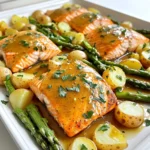
Sheet Pan Honey Mustard Salmon
Savor a delicious and healthy dinner with this Sheet Pan Honey Mustard Salmon recipe! It's quick, easy, and perfect for busy weeknights. Featuring succulent salmon, tender baby potatoes, and crisp asparagus, all drizzled with a zesty honey mustard glaze, this dish is a flavor bomb you'll love. Click through to explore the full recipe and make your next meal unforgettable! #HoneyMustardSalmon #SheetPanDinner #HealthyRecipes #EasyMeals